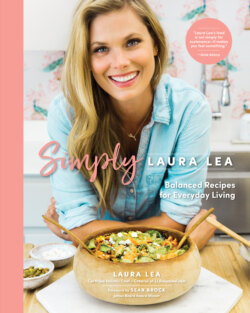Читать книгу Simply Laura Lea - Laura Lea - Страница 26
На сайте Литреса книга снята с продажи.
Оглавлениеsugar. The only downside I have heard is that
consuming excess erythritol can cause digestive
distress (similar to stevia), but a study published
in Food and Chemical Toxicology says otherwise:
“Following extensive safety evaluations . . . it has
been concluded that erythritol is well tolerated
in humans and does not cause any toxicologically
relevant effects even following ingestion of larger
quantities.”9 Thus, I have no problem using a brand of monkfruit that includes erythritol. Monkfruit may also have some notable health benefits. Mogrosides, the compounds that give monkfruit its sweetness, are also free-radical-fighting antioxidants and anti- inflammatory. Studies have found monkfruit to have anti-carcinogenic (anti-cancer) properties, as well as the capacity to improve diabetic conditions. Per the latter, a Chinese study notes that one of the monkfruit mogrosides “can provide a positive health impact on stimulating insulin secretion.”10
Why Lower-Sugar and Lower-Carb Recipes?
I didn’t consciously set out to include lower-sugar
and lower-carb recipes or recipe alternatives in
this cookbook. As I noted in my first book (and as I
do often on social media), natural sweeteners such
as honey, maple syrup, dates, and coconut sugar
are still sugar, and they should be treated as such:
enjoyed small quantities, viewed as indulgent.
Why? Because all sugars (and carbohydrates) break
down into glucose, the simple sugar that our body
then uses for energy. Doesn’t sound too bad, right?
The problem comes when we consume more glucose
than our body needs. Not only does the body then
begin to store glucose as fat, high amounts of glucose
and high sugar intake cause a pro-inflammatory
state, which can contribute to cardiovascular disease
and a host of metabolic diseases, such as type II
diabetes. Even armed with that knowledge, I found
myself eating increasing amounts of these natural
sweeteners in the fall and early winter of 2018,
probably due to the stress of writing a book. The
result? I noticed that my sugar cravings began to
control my life, and I found myself eating half a batch
of cookies or an entire bar of dark chocolate instead
of my usual single-serving portion (okay, sometimes
double). It seemed that my blood sugar was on a daily
roller coaster.
To combat my growing sugar addiction, I began
swapping the natural sweeteners for non-nutritive
sweeteners such as monkfruit and stevia. I also
substituted some of my complex carbohydrates,
such as quinoa, chickpea pasta, sweet potatoes, and
fruit, for non-starchy vegetables, such as zucchini,
broccoli, cauliflower, bell peppers, and leafy greens.
I began to include more healthy fats in my meals,
snacks, and even beverages. Some of my favorite fats
are avocado and avocado oil, coconut oil, coconut
milk, butter, beef, yogurt, and cheese from 100
percent pasture-raised cows, wild-caught salmon,
nuts and seeds, nut and seed butters, and olives.
When I made these simple swaps, my sugar
cravings quickly diminished—in approximately ten
days. I felt incredibly satisfied throughout the day,
and I didn’t experience “hanger” (that gotta have
food hungry-angry feeling) as often. My overall mood
improved, and I stopped having afternoon energy
crashes. In addition, my palate changed, and I now
find foods much sweeter than before. This makes it
easier to satisfy a sweet tooth when it does crop up.
After a few months of following these changes
consistently, I began bringing more complex
carbohydrates back into my diet (because what is
a world without sweet potatoes?) when I felt like
I needed them. You might be wondering, what
does that feel like? Well, for me, I need a few more
complex carbohydrates when I am eating plenty of
healthy fats, protein, and non-starchy vegetables,
but I am still tired and sluggish throughout the day,
9 I. C. Munro et al., “Erythritol: An Interpretive Summary of Biochemical, Metabolic, Toxicological and Clinical Data,” Food and Chemical Toxicology 36, no. 12 (December 1998): 1139–74, abstract, https://www.ncbi.nlm.nih.gov/pubmed/9862657.
10 Y. Zhou et al., “Insulin Secretion Stimulating Effects of Mogroside V and Fruit Extract of Luo Han Kuo (Siraitia Grosvenori Swingle) Fruit Extract,” Yao Xue Xue Bao 44, no. 11 (November 2009): 1252–7, abstract, https://www.ncbi.nlm.nih.gov/pubmed/21351724.
